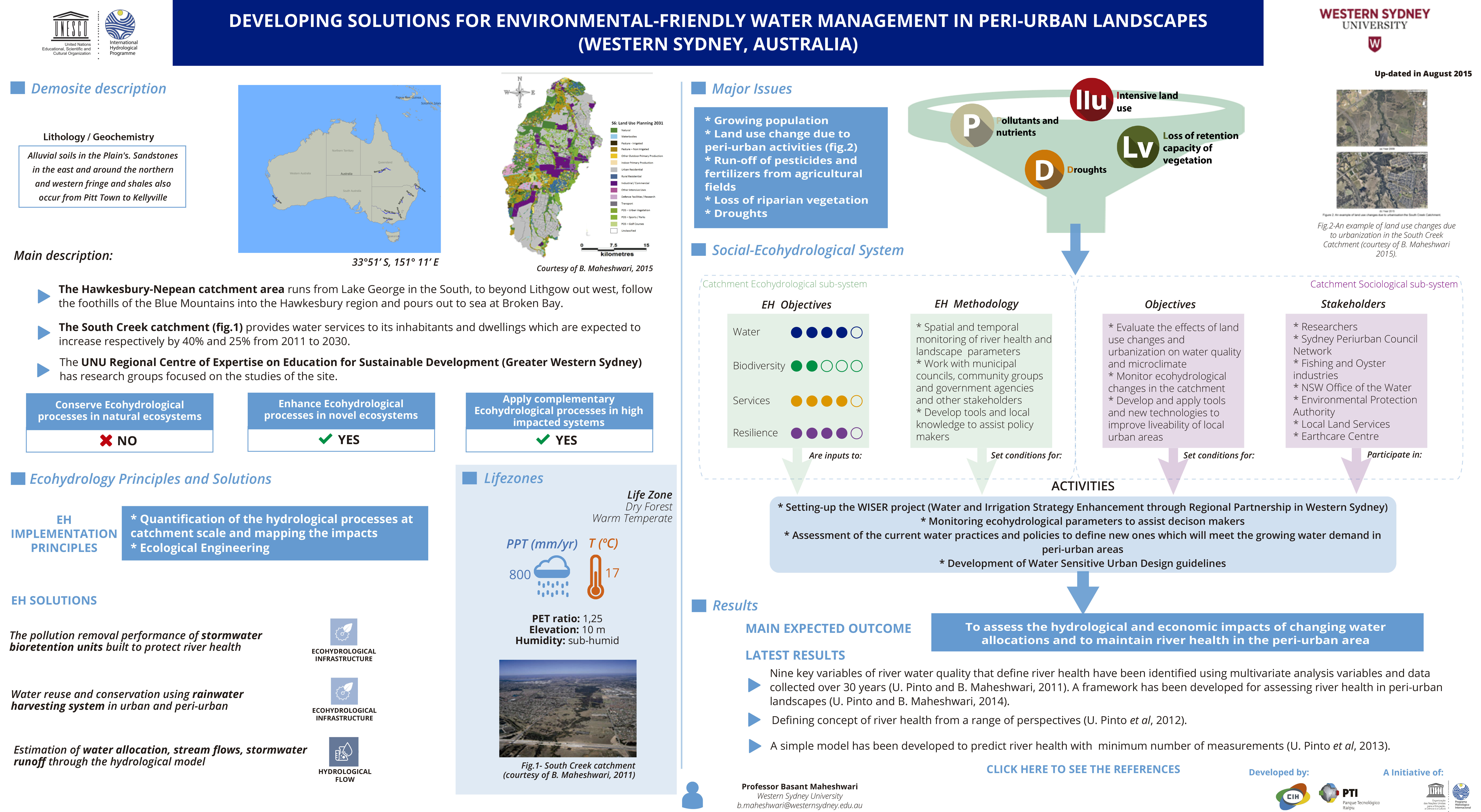DEVELOPING SOLUTIONS FOR ENVIRONMENTAL-FRIENDLY WATER MANAGEMENT IN PERI-URBAN LANDSCAPES(WESTERN SYDNEY, AUSTRALIA)

Description
Location


Sketch

Information about lithology/geochemistry:
Alluvial soils in the Plain's. Sandstones in the east and around the northern and western fringe and shales also occur from Pitt Town to Kellyville
Main Description
- The HawkesburyNepean catchment area runs from Lake George in the South, to beyond Lithgow out west, follow the foothills of the Blue Mountains into the Hawkesbury region and pours out to sea at Broken Bay.
- The South Creek catchment (fig.1) provides water services to its inhabitants and dwellings which are expected to increase respectively by 40% and 25% from 2011 to 2030.
- The UNU Regional Centre of Expertise on Education for Sustainable Development (Greater Western Sydney) has research groups focused on the studies of the site.
Enhance ecohydrological processes in novel ecosystem
YES
Apply complementary Ecohydrological processes in high impacted system
YES
This table presents the different categories of ecosystem services that ecosystem can provide, divided in:
Provisioning Services are ecosystem services that describe the material or energy outputs from ecosystems. They include food, water and other resources.

Food: Ecosystems provide the conditions for growing food. Food comes principally from managed agro-ecosystems but marine and freshwater systems or forests also provide food for human consumption. Wild foods from forests are often underestimated.

Fresh water: Ecosystems play a vital role in the global hydrological cycle, as they regulate the flow and purification of water. Vegetation and forests influence the quantity of water available locally.
Regulating Services are the services that ecosystems provide by acting as regulators eg. regulating the quality of air and soil or by providing flood and disease control.

Local climate and air quality: Trees provide shade whilst forests influence rainfall and water availability both locally and regionally. Trees or other plants also play an important role in regulating air quality by removing pollutants from the atmosphere.

Waste-water treatment: Ecosystems such as wetlands filter both human and animal waste and act as a natural buffer to the surrounding environment. Through the biological activity of microorganisms in the soil, most waste is broken down. Thereby pathogens (disease causing microbes) are eliminated, and the level of nutrients and pollution is reduced.
Ecosystem services "that are necessary for the production of all other ecosystem services". These include services such as nutrient recycling, primary production and soil formation.
Cultural Services corresponds nonmaterial benefits people obtain from ecosystems through spiritual enrichment, cognitive development, reflection, recreation, and aesthetic experiences.

Recreation and mental and physical health: Walking and playing sports in green space is not only a good form of physical exercise but also lets people relax. The role that green space plays in maintaining mental and physical health is increasingly being recognized, despite difficulties of measurement.

Tourism: Ecosystems and biodiversity play an important role for many kinds of tourism which in turn provides considerable economic benefits and is a vital source of income for many countries. In 2008 global earnings from tourism summed up to US$ 944 billion. Cultural and eco-tourism can also educate people about the importance of biological diversity.

Aesthetic appreciation and inspiration for culture, art and design: Language, knowledge and the natural environment have been intimately related throughout human history. Biodiversity, ecosystems and natural landscapes have been the source of inspiration for much of our art, culture and increasingly for science.

Spiritual experience and sense of place: In many parts of the world natural features such as specific forests, caves or mountains are considered sacred or have a religious meaning. Nature is a common element of all major religions and traditional knowledge, and associated custos are important for creating a sense of belonging.
Lifezones

![]()
PPT(mm/yr): 800.0
![]()
T(ºc): 17.0
| Elevation of demosite: | 10.0 meters above sea level |
| Humidity: | Sub-Humid |
| PETr (by year): | 1.25 |
EH Principles
Quantification of the hydrological processes at catchment scale and mapping the impacts
Ecological engineering (integration, dual regulation and biotechnologies in catchment scale for enhancement of ecological potential)
ECOHYDROLOGY ENGINEERING SOLUTIONS
Water reuse and conservation using rainwater harvesting system in urban and peri-urban
 Ecohydrological Infrastructure
Ecohydrological Infrastructure
The pollution removal performance of stormwater bioretention units built to protect river health
 Ecohydrological Infrastructure
Ecohydrological Infrastructure
Estimation of water allocation, stream flows, stormwater runoff through the hydrological model
 Hydrological Flow
Hydrological Flow
Major Issues
- Growing population.
- Land use change due to peri-urban activities (fig.2).
- Run-off of pesticides and fertilizers from agricultural fields.
- Loss of riparian vegetation.
- Droughts.






Expected Outcomes
To assess the hydrological and economic impacts of changing water allocations and to maintain river health in the peri-urban area.
Latest Results
- Nine key variables of river water quality that define river health have been identified using multivariate analysis variables and data collected over 30 years (U. Pinto and B. Maheshwari, 2011). A framework has been developed for assessing river health in peri-urban landscapes (U. Pinto and B. Maheshwari, 2014).
- Defining concept of river health from a range of perspectives (U. Pinto et al, 2012).
- A simple model has been developed to predict river health with minimum number of measurements (U. Pinto et al, 2013).
Contacts
Professor Basant Maheshwari
- b.maheshwari@westernsydney.edu.au
- http://www.uws.edu.au/
- Western Sydney University
- http://www.uws.edu.au/

Social ecohydrological system
EH Objectives
EH Methodology
Catchment Ecohydrological sub-system
Objectives
Stakeholders
Catchment Sociological sub-system
Activities